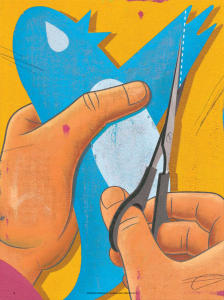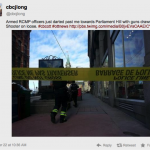#twitterfight
Childish sniping, iffy ethics and the sheer lunacy of public feuds expose the human side of journalists. Is that wrong?
 Jonathan Goldsbie is a Toronto civic geek. He bikes everywhere, drinks ethically sourced coffee and likes talking about local indie music in Kensington Market. And, of course, he tweets. Constantly. Over his two-and-a-half years on Twitter, he’s averaged about 35 tweets per day. But somehow, this seemingly harmless dude landed himself in one of the city’s most talked-about Twitter brawls of 2011. Goldsbie is such a prolific tweeter that early this year, many of his followers banded together through the hashtag #goldsbiephone to raise funds and update his “Flintstonian pterodactyl” to a fancy new Android. Armed with a new smartphone, he continues to take joy in calling people out. The Globe and Mail deemed him “loyal to few, loved and loathed in equal parts by many.”
Jonathan Goldsbie is a Toronto civic geek. He bikes everywhere, drinks ethically sourced coffee and likes talking about local indie music in Kensington Market. And, of course, he tweets. Constantly. Over his two-and-a-half years on Twitter, he’s averaged about 35 tweets per day. But somehow, this seemingly harmless dude landed himself in one of the city’s most talked-about Twitter brawls of 2011. Goldsbie is such a prolific tweeter that early this year, many of his followers banded together through the hashtag #goldsbiephone to raise funds and update his “Flintstonian pterodactyl” to a fancy new Android. Armed with a new smartphone, he continues to take joy in calling people out. The Globe and Mail deemed him “loyal to few, loved and loathed in equal parts by many.”
Toronto Sun columnist Sue Ann Levy seems to be a member of the loathing contingent. She made it clear in her columns leading up to Pride 2011 that she wanted the city to stop funding Pride if Queers Against Israeli Apartheid was to march in the parade. So in March, Levy, who is Jewish, wrote to several Jewish community leaders, urging them to contact councillors and strip Pride Toronto of city money. The letter quickly leaked and, before long, Andrea Houston wrote a story about it for Xtra!, a gay and lesbian newspaper. She quoted city councillor Adam Vaughan: “[Sue Ann Levy] has an agenda. She is on the Ford team. She is doing work for the mayor… Take everything she says in light of that.” The pro-Palestinian organization bowed out of the parade after city hall threatened to pull Pride’s funding.
When Goldsbie heard about the letter, he was shocked: “I couldn’t believe the email had her Sun signature on it.” So he tweeted, “It can’t be kosher for a full-time newspaper columnist to be campaigning for councillors’ votes on an item about which she often writes.” Levy bantered back and forth with Goldsbie and name-calling eventually ensued, culminating with Levy tweeting, “Thx to Adm Vaughan for calling me influential int Xtra trash piece…and thx to leftist blowhard for showing his true anti-semetic colours.” Goldsbie responded: “You know, I’m pretty sure labelling a public figure anti-Semitic is defamatory, even if you misspell it.” The Sunremoved Levy from the Pride beat and while councillors slugged it out over Pride Toronto funding at city hall, she took a trip. She returned and wrote in her column , “I was glad to be in Mexico that week.”
Levy isn’t the only journalist to cause a stir on Twitter. In August 2011, Dave Naylor from the Calgary Sun came under attack for tweeting, “Maybe he’s not dead. Maybe he’s just stiff and needs a good massage,” after Jack Layton’s death. He was referencing a story that broke during the last federal election about the late NDP leader being found in a massage parlour 15 years earlier. Michael Coren, a Sun News television host, tweeted, “Still world hunger. More prayers to Jack please!” Despite many angry responses, Naylor and Coren managed to hold on to their jobs.
Damian Goddard, an on-air host from Rogers Sportsnet, was not so fortunate. The network fired him the day after he tweeted his unenthusiastic opinions about gay marriage in May 2011. (He said he supported “the traditional and TRUE meaning of marriage.”) And Octavia Nasr, CNN’s senior editor for Middle Eastern affairs, experienced a similar fate. She tweeted in July 2010, “Sad to hear of the passing of [spiritual leader] Sayyed Mohammed Hussein Fadlallah…One of Hezbollah’s giants I respect a lot.” Although Nasr tried to explain, saying she respects Fadlallah because he was a proponent of women’s rights, it was of little use. CNN fired her three days later.
Unfortunately for journalists, nuances can’t be explained in 140 characters, which is why news organizations are nervous about Twitter. They would prefer that journalistic bickering, activism and stupid jokes stay private, confined perhaps to the smoky press clubs of yore.
In an effort to get their way, major news outlets have released social media guidelines. But many insiders criticize these documents for being too restrictive and ignoring the fact that journalists are people too. Twitter is a great way for reporters to find stories, locate sources and gain a bigger audience—but the let-it-all-hang-out transparency also calls into question the myth of objectivity that underpins the entire profession.
As far back as 1898, The New York Evening Post believed impartial reporting would make more money because partisan papers couldn’t sell as much advertising space. Since then, impartiality has taken on a new meaning. In their 2007 book The Elements of Journalism, Bill Kovach and Tom Rosenstiel write, “In the end, the discipline of verification is what separates journalism from entertainment, propaganda, fiction or art.” It is the discipline of journalism—not the reporter—that is objective. The goal, according to this view, is to record what happened correctly, regardless of personal views about Hezbollah, gay marriage or left-wing politicians. (And if this happens to sell more ads, even better.)
But social media have exposed the messy, complicated and opinionated side of journalists. It turns out reporters aren’t just objective information-gathering machines—they’re people too. Hence the new guidelines that many organizations have created to try to avoid the next Twitter meltdown. The rules range from gentle reminders to stern warnings: the National Post points out that a source can Google reporters before an interview and the Sun tells its journalists that “the same legal implications of the newspaper apply to social media broadcasts, as regards libel and defamation.” (Calling someone anti-Semitic apparently has the okay, though.)
All of the guidelines have one thing in common: play your role. Headstrong columnists are going to have more leeway with their tweets than political reporters. And editors, for their part, shouldn’t blurt out rash responses, which is why Raju Narisetti, managing editor of The Washington Post, had to email his staff some guidelines after an employee responded to critical tweets on the paper’s Twitter account over a column about gay teen suicide. Dozens of websites reposted Narisetti’s email, which said, “No branded Post accounts should be used to answer critics and speak on behalf of the Post.” But a personal account still allows journalists to voice their opinions—be it shamelessly or naively.
Rules can’t define what proper composure is for every journalist. The Toronto Star released a new social media policy in April 2011. Part of it reads: “Never post information on social media that could undermine your credibility with the public or damage the Star’s reputation in any way, including as an impartial source of news. Such postings could be construed by readers as evidence that the Star’s news coverage is biased.”
But the paper has no intention of taping the mouths of its reporters. “My role is not to censor people,” says public editor Kathy English. “But making personal comments against or for any of the candidates in the election would put a reporter who was covering the election in a tricky spot.” English, who has held her position since 2007, hears from hundreds of readers every year and she knows they still expect impartiality. She truly believes, “You can show personality without expressing strong opinions on issues.”
In defending the paper’s policy, English points to Susan Delacourt, who shows plenty of personality through her Twitter account. The Parliament Hill reporter, who has collected over 12,000 followers since she started tweeting two years ago, doesn’t have a problem showing any strong points of view because she devotes criticism to the government as a whole: “The government is the one that holds power and it’s our job to keep that power in check.”
Delacourt thinks there’s a disturbing tendency to call critical journalists biased. “I strongly disagree with that. Journalists need to abide by openness and honesty.” Still, she admits that her Twitter account isn’t policed by the Star much. “Twitter doesn’t make money,” she notes, “and my bosses aren’t interested in things that don’t make money.”
Rosemary Barton, a CBC national reporter on the Hill, uses Twitter for things she might not necessarily say on television. “There’s more room for humour, more room for my personality,” she says. But when it comes to showing any political biases, she agrees with Delacourt: “I actually don’t have any political views. I’m equally tough on everybody.”
She thinks CBC’s social media guidelines leave plenty of room for her personality even though they say, “The expression of personal opinions on controversial subjects or politics can undermine the credibility of CBC journalism and erode the trust of our audience.” But Barton knows that if she wasn’t using Twitter she would be missing out on a lot of inside access to ministers on the Hill. Like journalists, politicians make announcements on Twitter, and they certainly follow what reporters are saying about them. Barton has more than 14,000 followers and has tweeted more than 25,000 times. She says politicians “see me up in the foyer where I’m doing my main job and crack jokes with me about references I’ve made on Twitter.” For her, that interaction is invaluable.
But the policies don’t sit well with everyone. GigaOm’s senior writer Mathew Ingram (formerly the communities editor at the Globe) is an outspoken critic of these guidelines. He believes the best way to make social media work is to allow reporters and editors “to be human” and engage with readers through Twitter, Facebook, story comments and blogs. Strict social media rules encourage fear and paranoia. “Sure, the best way to avoid skin cancer is to never go outside,” Ingram says. “You might not get skin cancer, but you have a really shitty life and you die unhappy.”
Goldsbie, because he’s a freelancer, has freedom when writing under his Twitter persona. He’s also on good terms with many city councillors, mostly lefties, which means he’s able to get exclusive information from them. Goldsbie was a political activist and blogger before reporting at city hall and his opinions are a big part of what landed him a gig as a regular on the National Post’s Posted Toronto Political Panel. He believes objectivity is an inherently difficult concept: “I established myself as a personality first and then got journalism work because of it,” he says. Despite (or because of) his obvious left-wing biases, Goldsbie has amassed 4,300 followers. As a self-defined guerrilla advocacy journalist, he is comfortable with Twitter because it helps define him.
Duncan Clark, the Post’s vice president of digital media, explains that columnists have particular knowledge in an area. “Goldsbie is a columnist and with that there’s a different expectation,” he says. On the other hand, if reporters on a beat are expressing opinions on Twitter, “it compromises their ability to report on that story.”
It’s okay for Levy or Goldsbie to express whatever opinions they want—within reason—because that’s their job. It gets trickier when Barton or Evan Solomon, host of CBC’s Power and Politics, decides to tweet because there appears to be no middle ground between the messy freedom that Ingram encourages and the bloodless objectivity that CBC expects.
Not that Solomon has a problem with the corporation’s social media policy. He thinks journalists are capable of doing their jobs without letting their personal opinions leak in. “I think that’s what separates good reporting from shit reporting,” he says. With a two hour Monday to Friday political show, he can’t afford to appear biased. “If I’m perceived to be promoting one political view over another, then I’m not serving my audience in a way that I’m supposed to,” he says. He likes to compare the impartiality of journalism to that of a judge. He asks, “Do you think a judge, who has all sorts of views, is capable of applying the law in an unbiased way?” For Solomon, this is a much better question than, “Does a judge have biases?”
Solomon isn’t the only person to compare the concept of journalistic objectivity to that of a judge. Tim Currie, who helped write the social media guidelines published by the Canadian Association of Journalists in 2011, says, “Although we all have opinions and we all have biases, we also know judges have biases but we hope that they’ll put them aside and apply the law as best they can.”
But judges and journalists have two very different occupations. Journalists pursue their own evidence and often their own cases, whether that’s hard-hitting investigative reporting or reviewing an album. Bert Bruser, a media lawyer, believes news outlets are right to be concerned about Twitter. He’s wary of journalists tweeting about their social causes. Although transparency makes good journalism, he notes, “What’s at stake is the credibility of the news organization—and that’s a big problem people are grappling with.” Bruser, who has a permanent legal office at the Star, thinks journalists often say things they regret on Twitter and it leads to trouble for both them and their bosses.
One of the biggest shortcomings of these new social media guidelines is they serve to illustrate that the problem isn’t that journalists are human, but that some reporters are allowed to reveal more of themselves than others. From Barton’s Twitter account, no one can tell if she’s married or has kids, but Goldsbie has no problem tweeting his insecurities about a T-shirt decision.
Sun Media’s social media manager, William Wolfe-Wylie, says the best approach is “understanding yourself, your audience and how those two players can interact.” This explains why Levy—the Sun’s Toronto columnist—can start political brawls: she does the exact same thing in her columns. Goddard couldn’t bash gay marriage because he was a sports anchor.
These policies, in the end, are more for the news outlets than they are for the journalists they employ: they legally ensure that a journalist can be fired for tweeting something offensive or stupid. The Star, the Sun and CBC are simply covering their asses. Most, if not all, of the social media policies can be condensed into one simple rule: if you wouldn’t like it up on a 30-foot billboard, don’t post it. Save it for the bartender at the dusty old press club.
For now, we’ve got a bunch of reporters tweeting, and not talking about their feelings. But there are some personalities who refuse to be defined by social media guidelines, and they are best followed with a bag of popcorn. The Post and the Sun have long moved on since the Pride debacle between Levy and Goldsbie. In fact, so have the two combatants. In July, Goldsbie tweeted, “Saw @SueAnnLevy’s post-Pride column blowing in the wind along the sidewalk. Picked it up; read it. Was actually moved.” Levy was quick to respond: “At least you didn’t find the column in a bird cage. Thanks for the vote of support!”
And a month later, almost to the day, they were back at it, fighting over library funding. #SomeThingsNeverChange.
Raeanne Mary Quinton was the Senior Online Editor for the Winter 2012 issue of the Ryerson Review of Journalism.















































